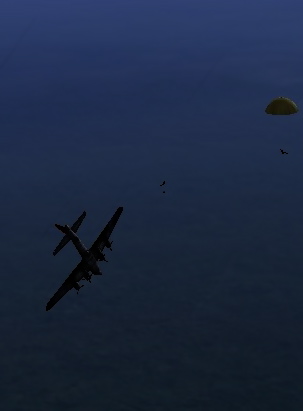Growing up to tales of heroism in the South Pacific sky, it was inevitable that I’d follow in my father’s footsteps and become a pilot myself. But “slipping the surly bonds of earth” isn’t as heavenly as it used to be after about 10,000 hours of flying over 45 years. Add to that the price of aviation gas, which hovers around $5 per gallon in the San Diego area, and the time I’ve spent in the cockpit lately has been barely enough to stay proficient. Nevertheless, I continue to log about 10 hours a week and thoroughly enjoy myself thanks to flight simulators that manage to blur the line between real and virtual.
As a youngster I remember sitting on a chair with a cutoff broom for a joystick between my legs, while storm clouds swirled past my cockpit. With an old radio with lots of knobs and dials for an instrument panel it was a crude simulator, but it worked.
Now, in the wee hours of the morning, I satisfy the craving to “dance the skies on laughter silver wings” by flying one of several flight simulators. Microsoft’s Flight Simulator is the granddaddy of them all, and dates back to the very first personal computers but it was recently abandoned by the company. However, software artists in Russia have taken up the slack with Rise of Flight (WWI) and Wings of Prey (WWII). These follow-ons to the renown classic you’ve probably never heard of, IL2 Sturmovik, have flight models and visuals that are so immersive ‘suspension of disbelief’ occurs on almost every flight. Sweaty palms and a pounding heart, when you’re badly infected with the magic and challenge of flight, aren’t the only physiological reaction produced on occasion. Other experiences are more cerebral, pondering what it must have been like when you’ve had a bad day in the skies over Europe.
What makes sims especially fun is the huge variety of aircraft that are available free as shareware, or as payware for less than the price of 15 minutes in a real Cessna 172. For example, the virtual Airco D.H.2, a flimsy crate, more struts and wires than airplane, comes complete with a fully functional cockpit and all four, count ’em four, instruments. It’s one of  17 Rise of Flight add-on aircraft available for less than $8.00. Powered by a pusher La Rhone rotary, Geoffrey de Havilland’s second design barely staggers into the air and handles like a hay wagon. It was, however, the first effective British single-seat fighter and enabled Royal Flying Corps pilots to confront the “Fokker Scourge” that gave Germany the advantage in late 1915. Until the British developed an interrupter gear that allowed guns to shoot through the propeller arc, pushers carried the burden of fighting and escort duties. To actually, um . . . virtually, fly one of those machines in combat is a unique experience that keeps me coming back for more.
On the other hand, if you feature yourself a Top Gun stud and have a need for speed, the IRIS F-14 has all the go fast you can handle and, I’ve discovered, then some. Carrier landings on a pitching deck and night aerial refueling will challenge even the best of the best.
Modern flight simulators produce terrain and sky visuals that are good enough that even after 16 years of flying sightseeing rides in a 1920’s biplanes I’m still inclined to fly through the Cascades mountains, perhaps in something a little faster, to just enjoy the sights.  Real Environment Xtreme produces clouds, haze, and water that are so realistic they look like photographs, not the product of a computer program.
By some good fortune I was accepted as a beta tester for a computer program that has become the pinnacle of flight sim terrain, ORBX/FTX’s Pacific Northwest (NA Blue). The package, created by a team of software artists with immeasurable patience, includes detailed terrain with entire forests of trees painstakingly placed by hand. The package covers western Washington State, Oregon and Canada as far north as the northern end of Vancouver Is. and it is, in a word, stunning.
I also tested several additional add-on airports in the area including 7S3, Stark’s Twin Oaks. A nice little country strip—with a nearby alpaca farm, a quarry, and orchards—it’s the kind of airport we all love for it’s down to earth country friendliness. On the ramp and in the pattern you’ll finder Cubs and sailplanes and an occasional warbird in for a $100 hamburger. Here’s video that beautifully illustrates the area, airport, gliders. and tows. It’s titled Slowdown – Indian Summer at Stark’s Twin Oaks from Andreas Paschen on Vimeo.
Composing screenshots and making movies is yet another aspect of this passion of mine. All the images images that illustrate this post are screen grabs. And yesterday I discovered a new (free) package called FS Recorder that allows you to record and replay a flight so you can fly as your own wingman.
So much fun, so little time.
High Flight
Oh! I have slipped the surly bonds of earth
And danced the skies on laughter-silvered wings;
Sunward I’ve climbed, and joined the tumbling mirth
Of sun-split clouds – and done a hundred things
You have not dreamed of – wheeled and soared and swung
High in the sunlit silence. Hov’ring there
I’ve chased the shouting wind along, and flung
My eager craft through footless halls of air.
Up, up the long delirious, burning blue,
I’ve topped the windswept heights with easy grace
Where never lark, or even eagle flew –
And, while with silent lifting mind I’ve trod
The high untresspassed sanctity of space,
Put out my hand and touched the face of God.
Pilot Officer Gillespie Magee
No 412 squadron, RCAF
Killed 11 December 1941






